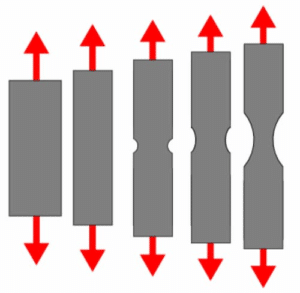Tensile strain is a term used to describe the amount of deformation or stretching that occurs in a material when it is subjected to a pulling force or tension. It is a measure of how much a material has been elongated compared to its original length.
Some daily life examples are listed below:
- Stretching a rubber band: When you stretch a rubber band, you are applying a tensile force to it, which causes it to elongate. The amount of elongation relative to the original length of the rubber band is a measure of the tensile strain.
- Pulling a piece of chewing gum: Similar to a rubber band, when you pull a piece of chewing gum, it experiences tensile strain. The more force you apply, the greater the strain on the gum.
- Stretching a piece of dough: When you stretch a piece of dough, you are causing it to elongate due to the tensile force you are applying. The amount of elongation is a measure of the tensile strain.
- Holding a weight with a rope: When you hold a weight with a rope, the rope experiences tension and elongates slightly. The elongation of the rope is a measure of the tensile strain it experiences.
Table of Contents
Formula of Tensile Strain
The formula for tensile strain (ε) is:
ε = (ΔL / L)
where:
- ΔL is the change in length of the material;
- L is the original length of the material.
This formula gives us a measure of how much the material has stretched or elongated due to the tensile force applied to it. Tensile strain is a dimensionless quantity, meaning it has no units, as the change in length is divided by the original length, which cancels out the units.
Significance of Tensile Strain
- Tensile strain helps us understand how a material will behave under tensile forces.
- The magnitude of tensile strain is directly related to the amount of stress applied to the material.
- Measuring tensile strain under different stress levels can help determine a material’s mechanical properties, such as Young’s modulus, yield strength, and ultimate tensile strength.
- Understanding the behavior of materials under tensile strain is crucial for designing and manufacturing structures and products that can withstand various loads and stresses without breaking or deforming excessively.
- This knowledge is applied in various fields, including aerospace, automotive, construction, and many others, to ensure the safety and reliability of the products and structures used in daily life.
Stress Strain Curve

Tensile Force Definition
- Tensile force is a pulling or stretching force applied to an object.
- It tries to elongate or deform the object along its axis.
- Tensile force acts in opposite directions on opposite ends of a material.
- It is the force that attempts to pull the object apart.
- Tensile force is encountered when objects or materials are subjected to stretching or elongation.
- Examples include pulling a rope, stretching a rubber band, or applying tension to a metal wire.
- The formula for tensile force is given by F = A * σ, where F represents the tensile force, A represents the cross-sectional area of the material, and σ represents the stress (force per unit area) applied to the material.
- Tensile force is crucial in engineering, construction, and material testing.
- It helps determine the strength and integrity of materials under tension.

Solved Problems-Tensile Strain
| No. | Question | Given Terms | Formula | Answer |
| 1. | What is the tensile strain if a steel rod of length 1m is stretched to a length of 1.1m under a tensile stress of 100 MPa? | Length (L₀) = 1m, Change in Length (ΔL) = 0.1m, Tensile Stress (σ) = 100 MPa, Young’s Modulus (E) = 200 GPa | ε = ΔL/L₀ | ε = 0.1/1 = 0.1 |
| 2. | A wire of length 5m and radius 0.5mm is stretched by 1mm under a tensile stress of 100 MPa. Calculate the tensile strain and the Young’s modulus of the wire. | Length (L₀) = 5m, Change in Length (ΔL) = 1mm, Tensile Stress (σ) = 100 MPa, Radius (r) = 0.5mm | ε = ΔL/L₀, E = σ/ε * (r²/4) | ε = 1/5000 = 0.0002, E = (10010⁶)/(0.0002 * 3.14 * (0.510⁻³)²/4) = 5*10¹⁰ Pa |
| 3. | A copper wire of length 2m and cross-sectional area 2 mm² is subjected to a tensile stress of 50 MPa. Calculate the change in length of the wire and the tensile strain. | Length (L₀) = 2m, Tensile Stress (σ) = 50 MPa, Cross-sectional Area (A) = 2 mm², Young’s Modulus (E) = 120 GPa | ΔL = σL₀/(EA), ε = ΔL/L₀ | ΔL = (5010⁶2)/(12010⁹210⁻⁶) = 0.42 mm, ε = 0.42/(210³) = 0.00021 |
| 4. | A steel wire of length 10m and cross-sectional area 1 mm² is stretched under a tensile stress of 100 MPa. If the wire elongates by 0.2mm, calculate the Young’s modulus of the steel wire. | Length (L₀) = 10m, Tensile Stress (σ) = 100 MPa, Cross-sectional Area (A) = 1 mm², Change in Length (ΔL) = 0.2mm | E = σL₀/(AΔL) | E = (10010⁶10)/(110⁻⁶0.2) = 5*10¹¹ Pa |
Exams Related Questions
| # | Question | Answer |
| 1. | What is tensile strain? | Tensile strain is a measure of the amount of deformation or stretching that occurs in a material when it is subjected to a pulling force or tension. It is a measure of how much a material has been elongated compared to its original length. |
| 2. | What is the formula for tensile strain? | The formula for tensile strain (ε) is: ε = (ΔL / L), where ΔL is the change in length of the material and L is the original length of the material. |
| 3. | What is the significance of tensile strain in materials science and engineering? | Tensile strain is significant in materials science and engineering because it helps us understand how a material will behave under tensile forces. It also helps in determining the mechanical properties of a material such as Young’s modulus, yield strength, and ultimate tensile strength. This knowledge is essential for designing and manufacturing structures and products that can withstand different loads and stresses without breaking or deforming excessively. |
| 4. | How is tensile strain related to stress? | Tensile strain is directly related to stress, which is the force per unit area applied to a material. The magnitude of the tensile strain is directly proportional to the amount of stress applied to the material. |
| 5. | What are some examples of tensile strain? | Examples of tensile strain include stretching a rubber band, pulling a piece of chewing gum, stretching a piece of dough, and holding a weight with a rope. In all these cases, the material experiences elongation due to the tensile force applied to it. |
More Links
Stress in Physics| Definition and Easy Examples
Tensile Stress – Definition, Formula, SI Unit, and FAQs
Yield Point| Definition and Stress-Strain Relation
Tension Formula| Daily Life Examples
Flexural Strength| Simple Definition and Daily Life Examples
Strain Energy- Definition, Formula and Daily Life Examples
Latest posts by Umair Javaid, PhD Student (see all)
- BCl3 Lewis Structure in four simple steps - November 1, 2023
- PH3 Lewis Structure in four simple steps - October 8, 2023
- PF3 Lewis structure in four simple steps - September 24, 2023



